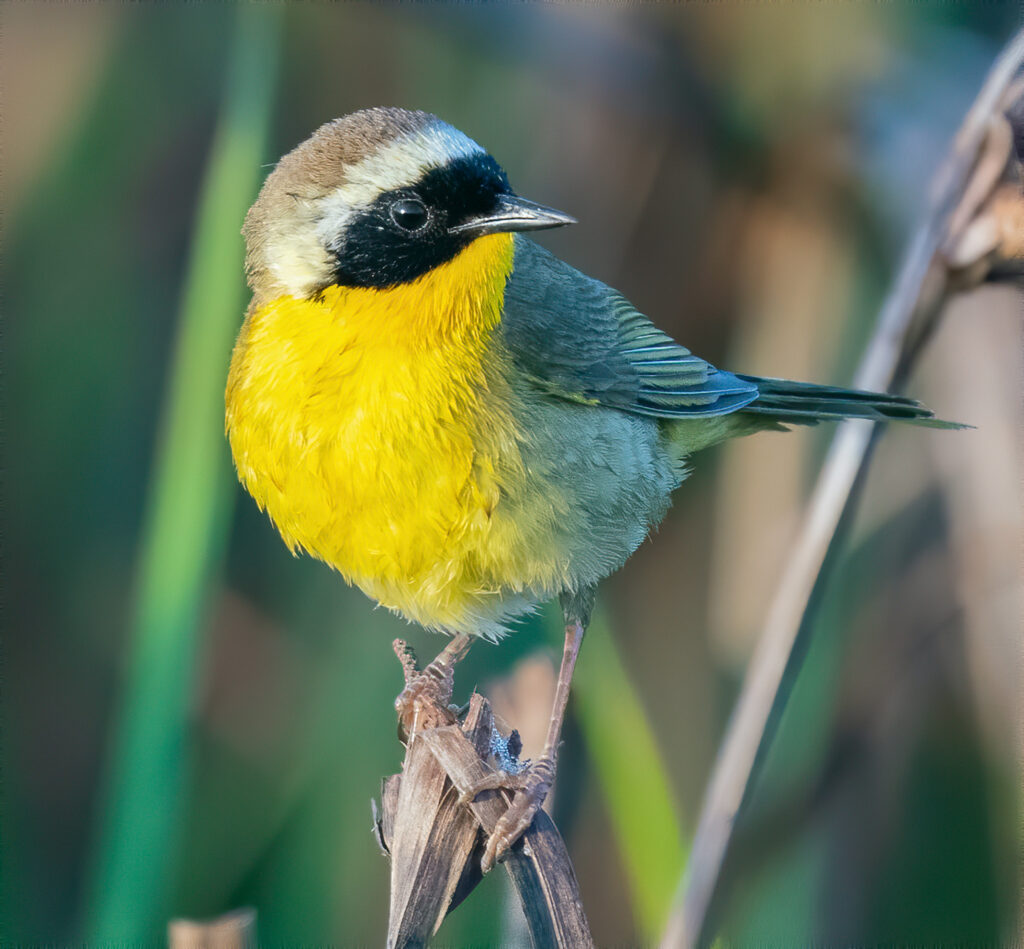Common Yellowthroat
Geothlypis trichas
The Common Yellowthroat stays close to the ground and uses stealth to survive!
Advertisement
Common Yellowthroat Scientific Classification
- Kingdom
- Animalia
- Phylum
- Chordata
- Class
- Aves
- Order
- Passeriformes
- Family
- Parulidae
- Genus
- Geothlypis
- Scientific Name
- Geothlypis trichas
Read our Complete Guide to Classification of Animals.
Common Yellowthroat Conservation Status
Common Yellowthroat Facts
- Prey
- Insects, spiders, larvae, invertebrates
- Main Prey
- Insects
- Name Of Young
- Chicks
- Group Behavior
- Solitary/Pairs
- Flocks
- Fun Fact
- The Common Yellowthroat stays close to the ground and uses stealth to survive!
- Estimated Population Size
- 77 million mature individuals
- Biggest Threat
- Habitat degradation
- Most Distinctive Feature
- Black mask rimmed in white above
- Distinctive Feature
- Bright yellow bib and underparts; olive-brown upper parts; sharp, pointed black bill; black eyes; pinkish legs and feet; females lack mask
- Other Name(s)
- Maryland Yellowthroat, Mascarita común (Spanish), Paruline masque (French)
- Wingspan
- 5.9 - 7.5 inches
- Incubation Period
- 12 days
- Age Of Fledgling
- 10 - 12 days
- Habitat
- Marshes, wetlands, open pine forests, grasslands, prairies, shrublands, other areas with dense, low vegetation
- Predators
- Hawks, falcons, Loggerhead Shrikes, raccoons, mice, chipmunks, snakes, skunks, opossums
- Diet
- Insectivore
- Lifestyle
- Diurnal
- Solitary
- Flock
- Pair
- Favorite Food
- Insects
- Common Name
- Common Yellowthroat
- Special Features
- Black mask with white rim above; bright yellow underparts
- Number Of Species
- 1
- Location
- North America, Central America and the Caribbean
- Average Clutch Size
- 4
- Nesting Location
- On the ground or near the ground in dense vegetation
- Migratory
- 1
Common Yellowthroat Physical Characteristics
- Color
- Brown
- Yellow
- Black
- White
- Olive
- Skin Type
- Feathers
- Lifespan
- 10 years
- Weight
- 0.3 ounces
- Length
- 4.3 - 5.1 inches
- Age of Sexual Maturity
- 1 year
- Venomous
- No
- Aggression
- Medium
View all of the Common Yellowthroat images!
The Common Yellowthroat stays close to the ground and uses stealth to survive!
The Common Yellowthroat is a cute little bird with a black mask and a bright yellow bib. It makes its home in North America, with some members of the species wintering in Central America and the Caribbean. Most often found in marshes, wetlands, or pine forests, this secretive bird makes use stealthy tricks to avoid predators. They just might evoke thoughts of Mission: Impossible as they dart into a thicket, sneak silently through the dense vegetation to their hidden nest, then leave the cover from an entirely different location. Listen closely and you are likely to hear the bird’s song. Males sing up to thousands of times per day!
Incredible Common Yellowthroat Facts
- Common Yellowthroats spend most of their time close to the ground.
- These birds are so light, they can perch on a single stalk of long grass.
- Grasshoppers and crickets are among their favorite foods.
- Female Common Yellowthroats choose mates based on the intensity of their markings.
- Male Common Yellowthroats can sing thousands of songs per day.
- Pairs care for their offspring a long time, sometimes even up to migration in the fall.
Where to Find the Common Yellowthroat
The Common Yellowthroat is found throughout much of North America, Central America and the Caribbean. It resides year-round in southern portions of the United States and much of Mexico. Throughout the rest of its range, it is migratory. Some of these warblers migrate long distances, from northern Canada all the way to Central America. Others migrate along much shorter routes.
These birds can be found almost anywhere that there is thick and abundant vegetation. They are typically seen in marshes and wetlands, particularly in areas that have lots of thick cover near the ground for them to forage and make their nests. Common Yellowthroats also inhabit grasslands, prairies and forests. They prefer open pine forests, but they can be found in other forested areas, especially during their migration.
Common Yellowthroat Nests
These birds make their nests on the ground or in low, dense vegetation like grasses, reeds, hedgerows, and thickets. Because they tend to live in and around wetlands and marshes, they will often build a little bit off the ground in areas prone to flooding. Very occasionally, they will build their nests in plants that are growing out of the water. Sometimes they build their nests with a roof, much like the Ovenbird which was named for its nest that looks much like an outdoor oven.
Scientific Name
The scientific name of the Common Yellowthroat is Geothlypis trichas. The word geothlypis comes from Greek roots meaning, essentially, ground bird. It is the name of the genus within the Parulidae family of New World warblers that contains yellowthroats. The Common Yellowthroat was described by Linnaeus in 1766 and was among the first birds of the New World officially described by scientists.
In Spanish, this species is known as Mascarita común, and in French its name is Paruline masque. Both names are indicative of the bird’s masked appearance.
There are currently 14 subspecies of Common Yellowthroats. These include the first, nominal subspecies, Geothlypis trichas trichas, named in 1766 and the latest addition in 1947. Although, as ornithologist A.J. van Rossem noted in 1941, there is much overlap in appearance between the subspecies, and they can be difficult to distinguish in the field.
Appearance
Common Yellowthroats are small birds with round bellies and round heads. They are roughly the size of a small sparrow, weighing only about 0.3 ounces, or 9 to 10 grams. They are approximately 4.3 to 5.1 inches long. Their tails average about 1.9 inches in length, and their wingspan ranges from 5.9 to 7.5 inches.
The most striking features of the male Common Yellowthroat are its black mask, which is rimmed in white above, and the bright yellow plumage on its underside. This bird has olive-brown upper parts, a bright yellow throat, and bright yellow under its tail. Its tail is relatively short and often cocked upright. It has black eyes, pinkish legs and feet, and a long, pointy black bill similar to that of a flycatcher.
The species is sexually dimorphic. Female Common Yellowthrowats do not have the mask that males wear, and they are more brownish on their upper parts. Their underparts are yellow, but the intensity of the color varies among subspecies and geographic location. Juvenile females are mostly brownish, with yellow under the tail. Juvenile males look similar to adults, but with just a hint of the mask they will eventually sport.

Common Yellowthroat,
Geothlypis trichas, perched in a marsh.
©DC Wildlife Photography/Shutterstock.com
Behavior
Common Yellowthroats are stealthy birds by nature. They live and make their nests in areas of dense cover, and then use sneaky tricks to avoid predators. Entering a thicket from one spot, they quietly flit unseen within the vegetation all the way to their nest, and then leave again from a completely different area. They also tend to dart out from a perch to catch prey on the wing, quickly flying back to cover.
Some birders insist the secretive birds can be found more easily by listening for their song. The high-pitched “wichety-wichety-wichety” call of the Common Yellowthroat is easy to recognize, and they sing a lot. Individual males have been recorded singing thousands of songs per day. They tend to stay close to the ground, not high in trees. They may be seen flitting up and down a single stalk of tall grass, a thin branch, or a slender reed.
These birds form socially monogamous pairs during breeding season, and even though the females may mate with more than one male, their mates can be quite aggressive in defending their territory. However, they are usually solitary during the winter. Common Yellowthroats often forage with mixed flocks of similar species during their migration.
Diet
Common Yellowthroats are insectivores. Their diet consists of insects and larvae they can catch on the ground and on the surfaces of plants, as well as those they can catch in the air. These birds are light and quick. Flitting along tiny branches or stems, they can snatch prey from almost any surface with speed and accuracy. They eat small insects like bugs, ants, termites, beetles and flies, as well as caterpillars and other larvae. Small grasshoppers and crickets make tasty meals for these warblers. They also eat spiders or other small invertebrates they find on plants or on the ground.
In the air, these birds dart out and catch their prey quickly. Then they retreat just as fast to the cover of dense vegetation. Slow moving moths and butterflies do not stand a chance against these swift birds. The warblers also eat damselflies, dragonflies, and even prey on bees and wasps.
Common Yellowthroat Reproduction
These birds reach sexual maturity at about one year of age. Males perform mating displays, flying up from cover while singing a high-pitched song, then dropping back down again. Females select a mate and the birds form pairs, but not strictly monogamous ones, as females often engage in extrapair mating with other males. Research shows that female Common Yellowthroats choose males as their mate or their extrapair partner based on plumage ornamentation. These features include the male’s mask and the size and intensity of color of his yellow bib.
Females build their cup-shaped nests on the ground or in low, dense vegetation. They make the nests from grass, sedges, and leaves, with softer materials on the inside. Then they lay an average of three to six eggs and have one to two broods per year. The female incubates the eggs for 12 days, during which time the male guards the territory and sometimes delivers food. Chicks fledge after 10 to 12 days.
According to research, Common Yellowthroat pairs feed and care for their offspring for a long time. This is especially true with regard to the second brood of the season. The parents and offspring may stay together all the way through migration. The birds migrate south in the fall, usually from September through October, and they return again in the spring.
Predators
Common Yellowthroats are vulnerable to birds of prey such as hawks, falcons, and even the diminutive Loggerhead Shrike. Nest predators are also a significant danger to these birds that nest so near the forest floor. Chicks and eggs can easily fall prey to animals such as snakes. Small mammals such as mice, chipmunks, raccoons, opossums, and skunks are also serious threats to these ground-nesting birds.
Lifespan of the Common Yellowthroat
The Common Yellowthroat lives approximately 10 years in the wild. The oldest recorded individual lived to an age of 11 years, 6 months. This bird is listed as a species of least concern by the IUCN Red List of Threatened Species. It has a population of approximately 77 million mature individuals, but its numbers are decreasing. Habitat degradation is one of the primary concerns. Predation and nest parasitism by the Brown-headed Cowbird are also threats.
Similar Animals
- Ovenbird – This bird makes its nest on the ground and spends much of its time in dense cover. It is also a member of the Parulidae family.
- Canada Warbler – This yellow-breasted warbler with a black bib migrates over 3,000 miles from Canada to South America twice each year.
- Kentucky Warbler – This warbler is from the same genus as the Common Yellowthroat. It is commonly found in the southeastern United States and is known for its yellow spectacles.
Common Yellowthroat FAQs (Frequently Asked Questions)
What does the Common Yellowthroat look like?
The male Common Yellowthroat has a black mask, rimmed above in white. It has yellow underparts with bright yellow on its bib and under its tail. It has a long, pointed, black bill, black eyes, pinkish legs and feet, and olive-brown plumage on its upper parts. Females are more brownish on their upperparts and lack the mask.
How big is the Common Yellowthroat?
The Common Yellowthroat is about the size of a small sparrow. It averages between 4.3 and 5.1 inches in length and weighs only 0.3 ounces. It is so light it can easily sit on a grass stem or a tiny twig.
What is the Common Yellowthroat’s wingspan?
The wingspan of the Common Yellowthroat is between 5.9 and 7.5 inches.
How fast do Common Yellowthroats fly?
Although Common Yellowthroats do not usually chase their prey for long distances, they can fly very fast, darting in and out of cover and catching insects on the wing.
How many varieties of Common Yellowthroats exist?
According to the Integrated Taxonomic Information System, there are currently 14 subspecies of Common Yellowthroats, the first having been described by Linnaeus in 1766 and the most recent in 1947.
What makes the Common Yellowthroat special?
The Common Yellowthroat is a master of stealth, hiding in low, dense vegetation and using sneaky moves to evade predators. It often enters a patch of cover in one location, then sneaks across to its nest, leaving from another location entirely.
Where do Common Yellowthroats live?
The breeding range for the Common Yellowthroat includes much of Canada, most of the United States, and a large portion of Mexico. Some members of the species winter in Mexico, Central America and the Caribbean. They tend to live in marshes, wetlands, grasslands, prairies or open pine forests with abundant low cover.
Do Common Yellowthroats migrate?
Many Common Yellowthroats migrate, with some traveling short distances and others going all the way from northern Canada to Central America or the Caribbean. Some populations remain in place year-round, particularly in the southern United States and much of Mexico.
What do Common Yellowthroats eat?
Common Yellowthroats are insectivores. They eat insects that they find on the ground and on plant surfaces as well as flying insects they catch on the wing. Grasshoppers and crickets are a favorite meal, as are beetles, bugs and ants. They also eat spiders, larvae, and other invertebrates.
How do Common Yellowthroats choose a mate?
Female Common Yellowthroats choose their mate based mainly on the intensity of the colors of his mask and bib. Males also perform fancy mating displays, darting straight up out of a patch of vegetation while singing a high-pitched song, then dropping back into cover.
Are Common Yellowthroats monogamous?
Common Yellowthroats form socially monogamous pairs, but the females engage in extrapair mating with other males. Mated pairs work together to raise the chicks that are produced, regardless of which male fathered them.
Where do Common Yellowthroats nest?
Common Yellowthroats nest in marshes, wetlands, grasslands, prairies, shrublands, and open pine forests. They prefer to live near water. They build their nests on the ground or just above, in low, dense vegetation. Rarely, they will even build nests on plants growing out of the water.
How many eggs does the Common Yellowthroat lay?
Common Yellowthroats lay between 3 to 6 eggs per brood. The average number of eggs per brood is 5. They have 1 to 2 broods each year.
When do Common Yellowthroats leave the nest?
The incubation period for Common Yellowthroats is 12 days, and chicks fledge after 10 to 12 more days. However, the parents care for them and feed them for a long time, sometimes up until migration begins in the fall.
How long do Common Yellowthroats live?
The average lifespan of a Common Yellowthroat is 10 years, but the longest living individual on record lived 11 years, 6 months.
Are Common Yellowthroats rare?
Common Yellowthroats are not rare. Their population is estimated at 77 million mature individuals, but that number is declining. Their range is vast, and they are listed as a species of least concern on the IUCN Red List of Threatened Species.
Thank you for reading! Have some feedback for us? Contact the AZ Animals editorial team.
Sources
- ITIS - Integrated Taxonomic Information System, Available here: https://www.itis.gov/servlet/SingleRpt/SingleRpt?search_topic=TSN&search_value=178944#null
- A.J. van Rossem, Available here: https://sora.unm.edu/sites/default/files/journals/condor/v043n06/p0291-p0292.pdf
- Kat Kerlin, Available here: https://www.ucdavis.edu/news/love-songs-warblers-pick-beat-fertile-females-neighborhood
- Corey R. Freeman-Gallant, et al., Available here: https://onlinelibrary.wiley.com/doi/pdf/10.1111/j.1558-5646.2009.00873.x
- Arthur Cleveland Bent, Available here: https://www.birdsbybent.com/ch91-100/yellowthroat.html

















